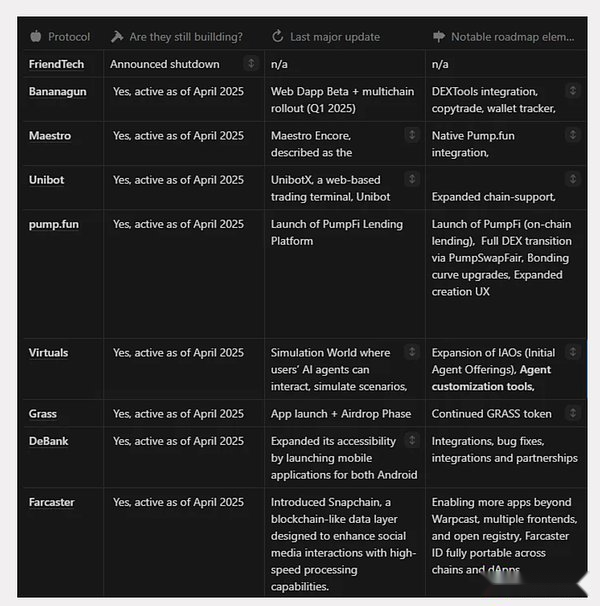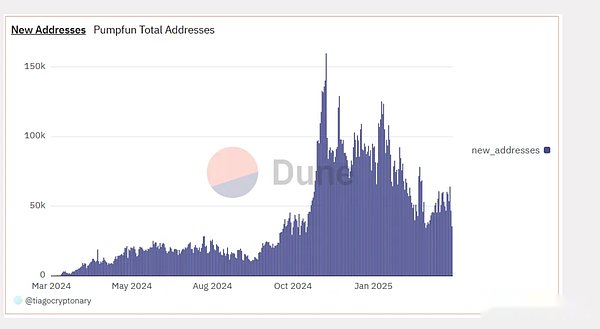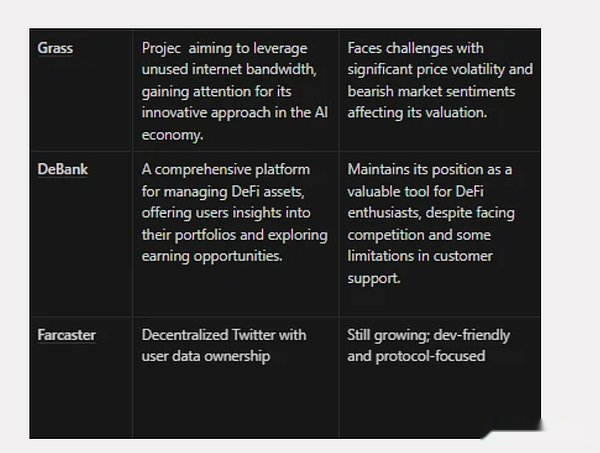
Author: Stacy Muur Translation: Shan Oppa, Bitchain Vision
People rarely leave because of problems with a certain agreement.More often, they leave because that story no longer develops—no new beliefs to follow, no new directions to align.
Web3 is a world, and “Web3 Protagonist Halo” is another level.
At that moment, a protocol suddenly became popular, and the timeline was full of its news, and each project was either integrating it or copying it.You must know that feeling.
FriendTech has had that kind of moment.Pump.fun definitely has it.Farcaster, Bananagun and Unibot also have them, each in their own cycles for different reasons.
That feeling was direct, quick, noisy.
But the more difficult truth is: the popularity will always shift.Not because the product failed, but because people found new toys that were more flashy.The shelf life of freshness is very short, and in the field of Web3, the spotlight never stays for a long time.
This article is not a eulogy.Not all of these agreements are “dead”.But they all went through the same process—from domination to silence.This post tells what those projects that once had the protagonist’s aura would look like when they no longer make headlines.
Who are we discussing
I stayed in this circle long enough to see this pattern clearly: a protocol became popular, occupied the entire timeline, and then quietly faded out.This table is a snapshot, not a success measure of TVL or token prices, but a measure of things that are harder to capture: attention, memory points, emotional resonance.These projects once dominated the timeline.Some are still persisting.
FriendTech, for example, has risen quickly and loudly, but its collapse is also complete – no roadmap, no user stickiness, no trace of recovery.Once the popularity passes, it becomes a burden.
Let’s take a look at Unibot: It survived hacking, cloning waves and market weakness, but is still considered one of the cleanest and best-used trading user experiences.
There is also Virtuals, one of the few projects that not only “survived” but completed “transformation”.It was originally just a prediction game based on the Base chain, but now it claims to be “Wall Street for Artificial Intelligence Agents.”This transformation is very rare in the crypto world, not to mention in projects born in degen gambling fields.
Pump.fun and Maestro are another story: not dead, just diluted.They are still in operation, and occasionally active peaks, but no one says they are revolutionary projects.Meme coin machines and sniper robot networks were not designed for long-term existence from the beginning, they were just for “explosion”.And they did explode – they just couldn’t explode the second time.
Then there are those “slow-hot” projects: Grass, DeBank, Farcaster.They each have their own “existence” – speculative returns, DeFi social identities, and decentralized dialogue.They are not ostentatious and do not disappear, but are quietly and intentionally continuously constructed outside the craze.

Still building, still iterating
If the previous table is about a mapping of “cultural gravity”, then this table records another thing completely: resilience.Because the heat is noisy, real construction is often quiet.
Some of these agreements are no longer “fire”, but they have not stopped.This table reveals projects that are still releasing updates, expanded integrations or strengthening infrastructure, although they are out of the public eye.
FriendTech?It has been officially closed in September 2024.
But what about the others?They are quietly accumulating compound interest – not on the timeline, but in the update log.

Peak activity ≠ persistent correlation
You can always feel the peak coming.Telegram group messages are flooded to the point where they cannot scroll.CT is full of order traders and half-baked posts.The protocol’s UI collapsed under the weight of its own hype.
But to maintain this state?That’s another matter.
Let’s analyze what the data shows, not what was once promised, but about the actual behavior of the user.

Virtuals
Virtuals’ agent creation peaked in October 2024, with more than 60 agents being created in a single day, followed by a wave of experiments in November and December.By early 2025, the number of daily agent creations has dropped to single digits.

Bananagun
Bananagun’s peak activity reached 700 million in July 2024.
Nine months later?Only 124.6 million.It fell by 82%.
It is still active and still delivering products, but is no longer the first choice.Telegram robots are pouring into the market, sniping transactions become the basic operation, and the narrative has shifted.Bananagun did not collapse, but just faded out of people’s horizon.
DeBank
DeBank experienced a surge in multi-chain registrations in mid-2023, then flattened completely.By early 2024, new users stopped emerging.The product itself did not collapse, but the narrative itself collapsed.DeFi social sounds good, but people don’t stay.Maybe they just focused on a few wallets and left.

Farcaster
This is what quiet accumulation looks like.Since the end of 2024, Farcaster’s daily active users have remained stable between 20,000 and 50,000, and user participation continues.There is no massive surge, nor airdrop bait.Only real use.When most social protocols are chasing noise, Farcaster develops a habit, but the real victory is people keep turning back.

Pump.fun
Pump.fun is a volcano.By the end of 2024, it minted millions of meme coins, with more than 150,000 new wallets appearing every day at its peak.After that, the curve dropped sharply.But it did not die out, but was stable at a casting volume of 50,000 to 60,000 per day.Still useful, still fun.It’s just that it is no longer the kind of cultural prosperity it once became briefly.

User buying stories
You can track usage on the dashboard.But what about belief?It exists elsewhere.To understand this, we must go back to the past, to the moments in which they have meaning.When FriendTech transforms social influence into mobility, Pump.fun feels like a game changer, and Farcaster is more like a declaration than just a social app.
Those are not only product releases, but also emotional turning points.People don’t just use these protocols, they also agree with them.FriendTech makes us feel like we are early participants.Pump.fun makes us feel smart.Farcaster makes us feel like we are part of something cleaner than Twitter.

FriendTech
FriendTech’s narrative is very attractive: tokenize your social relationships and monetize your influence.At its peak, it was not just another SocialFi tool, it was also a symbol of identity as an asset.But this story collapsed under its own weight.There is no roadmap, no participation cycle, no cultural endurance.This is a rare case where usage, narrative and product disappear simultaneously.Clean Rise and Clean Death.
Bananagun
Bananagun’s story is about leveling the playing field.Fast sniping, smart token economics, and robots for ordinary traders.It flourished in the Telegram robot wave, gaining fame by being sharper and faster than other competitors.What about now?It is still running, still serving traders.But it has become an infrastructure that is useful, but no longer leads the conversation.
Maestro
Maestro positions itself as the silent force behind a decentralized financial economy.It sells not trading robots, but leverage provided through infrastructure.But as less than 1% of the tokens it launched survived, the narrative has changed.Now, it’s more of a cautionary tale: what happens when open infrastructure becomes too open, too fast.
Unibot
Unibot focuses on pure speed and precision.It positioned itself as the tool of the most keen Telegram trader, not just a product, but an identity.Despite the competition and even a hack, Unibot’s reputation remains solid.Its functions continue to expand and its user base is maintained.It does not rely on virality, but on reliability.Such a reputation remains strong.
Pump.fun
Pump.fun democratizes token creation and brings the illusion of momentary relevance.At its peak, it feels like a new asset class is born every 10 seconds.But saturation comes quickly.Today, it is still active and still minting tokens, but the magic has faded.The story of “Everyone Can Start” lost its glory after “Everyone” was launched and most disappeared.
Virtuals
Originally a gambling speculative center riding on the Base narrative, Virtuals understands attention and then goes beyond it.It turns to AI agent coordination, redefining it as something bigger than the forecast market.Now it is no longer chasing meme, but building infrastructure.”Wall Street in AI Agent” is a bolder, more enduring narrative, one of the few protocols on this list to rewrite their own stories in real time.
DeBank
DeBank tells us that our DeFi portfolio is who we are.It makes tracking wallets social.This works well for a while.But the story stagnates.The product is still functional and respected among senior users, but it never jumps from a tool to a network.To some extent,DeBankIt is a victim of its own user experience stability, it is too good to be ignored, but not conspicuous enough to be widely publicized.
Farcaster
Farcaster’s launch comes with a grand idea: have your social relationships, have your voice.Instead of trying to clone Twitter, it reimagines the way on-chain publishing, interacting, and building.Current cognition proves this: Farcaster has not declined.It has been slowly accumulating trust and appeal, which is exactly what the long-tail narrative shows – less viral, but more resilient.
Other cases of weakening momentum worth noting
In addition to the more well-known examples mentioned above, several protocols have experienced similar patterns.They gain significant attention, usually leading the category for a short period of time, and then significantly decline in user activity, transaction volume, or correlation.These are not fringe projects.At its peak, they shape the market narrative and attract serious attention.This section highlights some of these cases.
Blast
It peaked at 900,000 MAU in a point-driven fanatic period in July 2024.It’s about 120,000 now.After points fatigue occurs, the earnings narrative fades quickly.
Scroll
1.2 million MAUs were reached when zkEVM hype peaked.Currently, it is about 111,000 MAU.Products are still being delivered, but the freshness has faded as infrastructure shifts to performance-first narratives.
Starknet
Bridged deposits in the TVL season reached $1.6 billion.It’s about $390 million now.Developer-first loyalty remains, but mainstream adoption seems to have slowed down due to cost and tool friction.
Renzo Protocol
The MAU peaked at 155,000; it is now slightly below 19,000.Still relevant in the liquidity resolution area, but is obscured by larger EigenLayer ecosystem players.
Sushiswap
ATH trading volume reached $11.3 billion.Now trading volume is about $200 million.It’s a cautionary tale of how dispersed visions, the spread of governance, and how CEX competition weakens first-mover advantage.
These agreements were once regarded as industry leaders.While some protocols are still active, their data suggests that the way users interact with them has changed today.Whether the decline originates from changes in the market environment, the evolution of narratives, or simply intensifying competition, the lessons are consistent.Early momentum is not the same as long-term existence.
in conclusion
In Web3, most things are not the end, they are just not talked about anymore.The items in this article were not selected because of failure.They were chosen because they were once important, brief and strong.Then, they quickly disappear, not because they lose money or users, but because they lose narrative momentum—a power that is hard to measure can turn the product into action.
A deeper pattern is the emotional arc about beliefs.When this arc flattens, users will disengage, not because they are disappointed, but because there is no reason to stay anymore.
This is why longevity is so rare in Web3.To last, a protocol must not only be available, it must also remain narratively vibrant.It requires not only providing benefits or tools, but also providing identity, possibility and reason to come back tomorrow.
The next breakthrough does not just come from solving problems, but from giving meaning.And those innovators who deserve attention have been working silently in the hustle and bustle, waiting for their second breakthrough.








